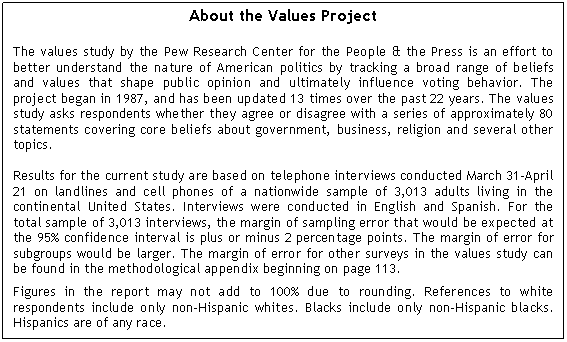Overview
Centrism has emerged as a dominant factor in public opinion as the Obama era begins. The political values and core attitudes that the Pew Research Center has monitored since 1987 show little overall ideological movement. Republicans and Democrats are even more divided than in the past, while the growing political middle is steadfastly mixed in its beliefs about government, the free market and other values that underlie views on contemporary issues and policies. Nor are there indications of a continuation of the partisan realignment that began in the Bush years. Both political parties have lost adherents since the election and an increasing number of Americans identify as independents.
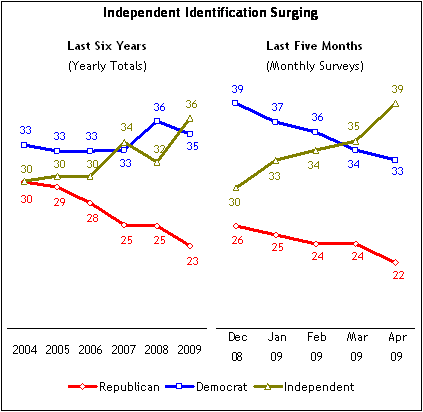
Click here to view a full-page Flash display, detailing the 70-year trend in party identification. The proportion of independents now equals its highest level in 70 years. Owing to defections from the Republican Party, independents are more conservative on several key issues than in the past. While they like and approve of Barack Obama, as a group independents are more skittish than they were two years ago about expanding the social safety net and are reluctant backers of greater government involvement in the private sector. Yet at the same time, they continue to more closely parallel the views of Democrats rather than Republicans on the most divisive core beliefs on social values, religion and national security.
While the Democrats gained a sizable advantage in partisan affiliation during George Bush’s presidency, their numbers slipped between December 2008 and April 2009, from 39% to 33%. Republican losses have been a little more modest, from 26% to 22%, but this represents the lowest level of professed affiliation with the GOP in at least a quarter century. Moreover, on nearly every dimension the Republican Party is at a low ebb – from image, to morale, to demographic vitality.
By contrast, the percentage of self-described political independents has steadily climbed, on a monthly basis, from 30% last December to 39% in April. Taking an average of surveys conducted this year, 36% say they are independents, 35% are Democrats, while 23% are Republicans. On an annual basis, the only previous year when independent identification has been this high was in 1992 when Ross Perot ran a popular independent candidacy.
As has been the case in recent years, more independents “lean” Democratic than Republican (17% vs. 12%). Yet an increasing share of independents describe their views as conservative; in surveys conducted this year, 33% of independents say they are conservatives, up from 28% in 2007 and 26% in 2005. Again, this ideological change is at least in part a consequence of former Republicans moving into the ranks of independents.

The latest values survey, conducted March 31-April 21 among 3,013 adults reached on landlines and cell phones, finds that there has been no consistent movement away from conservatism, nor a shift toward liberalism – despite the decline in Republican identification. In fact, fewer Americans say the government has a fundamental responsibility to provide a safety net than did so two years ago, and the share supporting increased help for the needy, even if the debt increases, has declined.
Yet more broadly, the public remains conflicted about government’s role. This is abundantly clear when it comes to opinions about health care: There is overwhelming agreement (86%) that the government needs to do more to make health care affordable and accessible. However, nearly half (46%) say they are concerned about the government becoming too involved in health care.
The public continues to be of two minds in its opinions about both government and business. Business generally, as well as Wall Street specifically, is viewed as playing a vital role in American society, but both are viewed as excessively concerned with amassing profits. In addition, although support for government assistance to the poor has declined, opinions about the government itself – whether it is wasteful and inefficient, whether it is run for the benefit of all – have moved in a positive direction.
Independents’ Views Determinative
Republicans and Democrats hold increasingly divergent views about the role of government, the environment and many other issues. As the partisan divide widens, the overall course of the public’s thinking is being determined by the tilt in opinions among the growing number of independents, who have a more moderate ideological point of view.
The political values of independents are mixed and run counter to orthodox liberal and conservative thinking about government. Over the past two years, both Republicans and independents have become more wary of expanding the social safety net. However, most independents join with most Democrats in saying that a free market economy needs government regulation to best serve the public interest. In effect, the public’s two-mindedness about government is a product of the way that independents, not partisans, think.
But independents continue to be much closer to Democrats than to Republicans with respect to social values, religiosity and beliefs about national security. Indices measuring the relative position of Republicans, Democrats and independents in these three areas show that the views of independents and Democrats have consistently been aligned, while Republicans continue to take a substantially more conservative position. (For more on partisan divides over values and where independents fit, see Section 11.)

Today’s GOP: Smaller, Slightly More Conservative
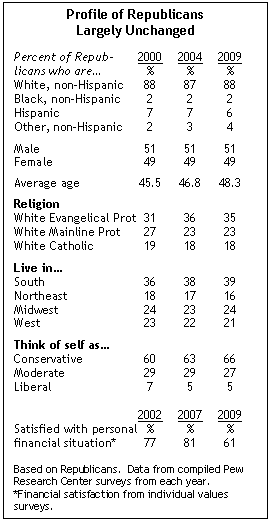
An analysis of 2009 data finds little evidence that as the number of Republicans has decreased in recent years they have become a much more conservative group. Two-thirds of Republicans (66%) describe their political views as conservative, which is up from 60% in 2000 and three points higher than in 2004 (63%). The percentage of Republicans who are white evangelical Protestants has not increased since 2004. And in general the values held by Republicans have not grown markedly more conservative over the past few years.
What is clear is that the Republican Party is facing formidable demographic challenges. Its constituents are aging and do not reflect the growing ethnic and racial diversity of the general public. As was the case at the beginning of this decade, Republicans are predominantly non-Hispanic whites (88%). Among Democrats, the proportion of non-Hispanic whites has declined from 64% in 2000 to 56%, as Latinos and people from other racial backgrounds have joined the ranks of the Democrats. At the same time, the average age of Republicans increased from 45.5 to 48.3, while the average age of Democrats has remained fairly stable. For the first time in at least two decades, Republicans are older than Democrats on average.
Republicans continue to be disproportionately comprised of Southerners (39%) and white evangelical Protestants (35%). However, these figures are largely unchanged from 2004 and up only slightly since 2000 as the GOP has lost supporters across all regions and religious groups.
The latest values survey also finds Republicans somewhat less optimistic in these tough economic times. The percentage of Republicans expressing satisfaction with their financial situation has fallen 20 points since 2007 – from 81% to 61%. Meanwhile, the changes among Democrats and independents have been more modest. About half of Democrats (49%) and independents (52%) say they are “pretty well satisfied” with their personal finances.
Similarly, fewer Republicans agree that are no “real limits to growth” in the United States than at any point in more than a decade; 60% say that now, down from 70% two years ago. There has been little movement in the views of Democrats (53% in 2009) or independents (54%).
Republicans also are increasingly critical of their own party. Just 24% of Republicans say their party is doing an excellent or good job of standing up for its traditional positions on such things as reducing the size of government, cutting taxes and promoting social values. In 2004, fully two-thirds (67%) give Republican Party high marks for standing up for its traditional positions. Positive evaluations of the GOP’s advocacy of its traditional positions have fallen more sharply among conservative Republicans than among than among moderate and liberal Republicans.
By comparison, Democrats offer substantially higher assessments of their party’s performance today than they have in recent years. Currently, 61% of Democrats say the party is doing an excellent or good job standing up for its traditional positions on such things as protecting the interests or minorities, helping the poor and needy, and representing working people. As recently as 2007, just 43% of Democrats expressed positive views about the party’s advocacy of its traditional positions. (For more on the political parties, see Section 1.)
Partisan Gap Widest Ever

The overall gap between the two parties in opinions about political values – which increased in 2003 – has hit another new high, with widening differences emerging over the government’s overall performance and its responsibilities to the poor. In the wake of the election, Republicans have swung to a much more critical view of government while more Democrats take a positive view than at any previous point in the 22-year history of this study.
Fully 75% of Republicans today say that government regulation of business does more harm than good, up from 57% two years ago. About the same number (74%) say when something is run by the government it is usually inefficient and wasteful, up from 61% in 2007. In both cases, Republican skepticism of government is now as great or greater than in 1994, prior to the GOP takeover of Congress. By contrast, the proportions of Democrats who are critical of government regulation of business and see the government as usually inefficient and wasteful have fallen sharply since 2007. (For more on the partisan divide, see Section 11.)
Public Not Turning Inward

There is no sign that the public is turning inward in response to difficult economic times. A larger share of Americans – and especially Democrats – completely agree that the U.S. should play an active role in world affairs.
Support for free trade agreements has actually increased over the past year (from 35% to 44%), and a majority (63%) continues to favor allowing illegal immigrants in the United States to gain citizenship if they meet certain conditions. The public remains divided over whether a strong military is the best way to ensure peace; a majority of independents (53%) now concur with this sentiment.
As other Pew Research Center surveys this year have found, however, the public clearly believes that domestic concerns should take precedence over foreign matters. More than three-quarters of Americans (78%) agree that “we should pay less attention to problems overseas and concentrate on problems here at home.” Yet that percentage is no higher than it has been the past two values surveys, in 2007 and 2003.
While opinions about global engagement and foreign affairs have not been affected by the recession, this is not the case with respect to environmental attitudes. The public continues to broadly support stricter environmental laws and regulation, but its willingness to pay higher prices, and suffer slower economic growth for the sake of environmental protection has declined substantially from two years ago.
In the new poll, 51% agree that protecting the environment should be given priority even if it causes slower economic growth and some job losses, down from 66% in 2007. At the same time, the share saying that people should be willing to pay higher prices in order to protect the environment has dropped from 60% in 2007 to 49% currently. This represents a 17-year low point on this measure. Surprisingly, declines since 2007 in support for economic sacrifices to protect the environment have been particularly large among young people and political independents.
The public remains broadly supportive of a variety of options for addressing the nation’s energy supply – 82% favor increased funding for research on wind, solar and other alternatives, while 68% say more offshore oil and gas drilling should be permitted. The idea of expanding nuclear energy continues to be more contentious (45% favor/48% oppose); 60% of college graduates favor increased use of nuclear power.
Economy Demotes Moral Values
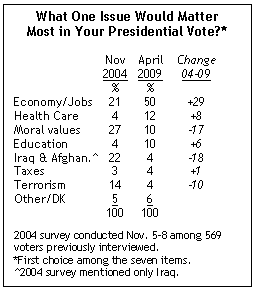
The values survey finds wide political and religious differences over traditional values and social policy issues, such as gay marriage. However, issues relating to religion and morality clearly have less political punch than during the 2004 election. The current survey finds that just 10% say they would consider moral values as the most important issue in their vote in a hypothetical presidential election.
In the 2004 presidential election, both the National Election Pool’s exit poll and a Pew Research Center post-election survey found a plurality of voters naming “moral values” as the most important issue in their vote. The Pew Research survey found 27% picking moral values as their top issue.
As the proportion citing moral values as most important has declined sharply since 2004, the economy and jobs have come to dominate the public’s concerns: 50% now point to the economy as most important compared with 21% of voters in the 2004 post-election survey. The percentages citing education and healthcare also are much higher than in November 2004.
Moreover, over the past decade there has been erosion in the percentage of Americans holding conservative views on family, homosexuality and gender roles. The decline in social conservatism is a result of generational change. Younger age cohorts are less conservative than older ones: Both of the younger age cohorts, Generation Y and Generation X, are less conservative than the Baby Boomers. The Silent Generation is the most conservative of all. Within age cohorts, changes over time in social conservatism have been very modest, indicating that the societal change in these values is mostly a consequence of newer generations replacing older ones.
Changing Views Among African Americans
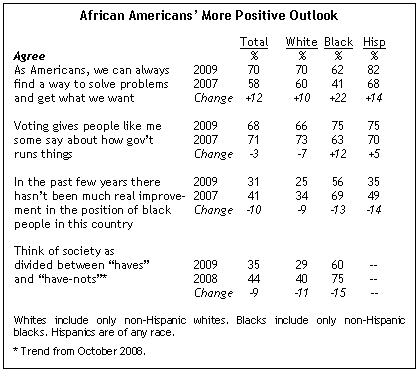
Following the election of Obama, blacks now have a more positive view of American society. Compared with 2007, there has been a striking increase in the proportion of blacks who agree that “as Americans we can always find a way to solve our problems and get what we want.” More than six-in-ten (62%) blacks now agree with this statement, up from 41% two years ago.
In addition, blacks offer a more positive opinion about voting: 75% agree that voting “gives people like me some say about how government runs things,” up from 63% in 2007. Whites’ views are somewhat more negative than they were two years ago. And fewer blacks and whites alike say that the nation is divided into “haves” and “have-nots.”
Yet the changes have been far less dramatic in measures specifically relating to race and racial progress. Fewer African Americans than in 2007 say there has been little improvement in the position of blacks, yet there have been comparable changes among whites and Hispanics; far more African Americans than whites or Hispanics continue to believe that there has not been much improvement in the status of blacks.
Moreover, just 30% of African Americans believe that discrimination against blacks is rare, which is little changed from 2007 (26%). And the survey also finds a large and continuing racial gap on the issue of whether blacks and other minorities should be given preferential treatment to improve their situation.
Roadmap to the Report
Section 1, which begins on page 11, describes long-term changes in party identification and provides a detailed examination of the shifts in the size and composition of the two parties. Section 2 (p. 29) details the public’s views about the government and the social safety net. Section 3 (p. 41) covers public attitudes toward business, Wall Street and labor unions. Section 4 (p. 45) covers opinions about religion and social issues. Section 5 (p. 55) describes changing attitudes toward race and race relations. Section 6 (p. 61) discusses the public’s views about foreign policy and national security. Section 7 (p. 69) examines the public’s confidence in the American people, satisfaction with personal finances and perceptions of inequality are covered in. Section 8 (p. 77) covers opinions about politics, the responsiveness of elected officials and voting. Public views about the environment and energy priorities are discussed in Section 9 (p. 83). Section 10 (p. 91) covers opinions about the online sharing of personal information, science and technology, and civil liberties. Finally, Section 11, which begins on p. 97, provides a historical overview of trends in the public’s values; it shows where partisan differences over values have widened, and how independents’ values have changed.
